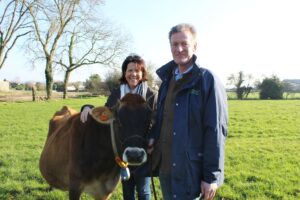When every rock off the coast had is name…. Paul Chambers is compiling a book of these names, before they disappear from memory. He asks: ‘Anyone who knows the names of any local rocks or coastal names please get in touch. The same is true for anyone who has old charts, pilot books or written descriptions of coastal names sitting in cupboards or drawers’

rocks, each of which probably has (or had) a name. Few of these were ever formally
recorded and were only ever known to local fishers.
ANYONE who has lived on Jersey for more than a few years can testify to the rapid pace of change affecting the Island’s landscape and culture.
The effect is often not revolutionary but cumulative and the consequence of many small alterations which collectively modify once familiar vistas or alter the familiarity of villages, roadsides, beaches or favourite walks. However, such change goes beyond what is visual and occasionally the people of Jersey will lose something without ever having been aware of its existence.
A case in point are traditional place names, the origins of which are embedded in a historical culture and languages that have long since ceased to be mainstream. In the absence of the ability to evolve, existing names will be steadily modified to reflect contemporary cultural needs. A local transport administrator once explained to me that his company was keen to Anglicise place names wherever possible so that tourists and spoken word software could pronounce them. Why keep a hard to use name like Samarés when it could become Manor Close instead?
Such decisions may grate with some but to others they are a practical response to wholesale societal change. The etymologist Allen Walker Read articulated such pragmatism when commenting on the introduction of slang words into the English language: ‘Nothing is absolute,’ he said, ‘Nothing is forever.’ Rather than opposing change, Read saw his role as documenting those words that were going out of use while studying the nature and origins of the new words that were replacing them.
Jersey is fortunate to have had a majority of its place names recorded and their origins explained in Jersey Place Names, a mammoth two volume work published by the Société Jersiaise in 1986. However, this project, while extraordinary and exhaustive, was very much a land based study and by their own admission, the authors did not feel comfortable taking their research below the high tide mark. Instead, the names of the Island’s coastal features were often provided in unannotated lists. The authors acknowledged this limitation to their work explaining that ‘the rock names are a study in themselves’.
This division is easy to understand as the number of names given to Jersey’s rocks, bays, islets, sandbanks and promontories almost equals those that exist on land. However, whereas the names of fields, streams and villages are often preserved on legal documents, property deeds and maps, a majority of Jersey’s marine names were never written down and only ever existed in the memories of fishers, pilots and others. This presented a serious logistical barrier both to the survival of names and to those wishing to record them.
In temps passé the fishers working out of the Island’s harbours would have known the names of dozens of rocks and other coastal features in their area. These names were not needed for prosaic reasons but were a tool of the trade being vital for navigation, fishing success and communicating positions with others. Some years ago an old Mîntchier (Minquiers’ fisher) explained to me that the reef’s many rock names had been an essential part of his fishing business. He said I should think of the rock names as being like stations on the London tube map, arranged so that he and others knew where their gear had been left, how to find particular fishing spots, where safe anchorages were, etc.
Other names were (and still are) used not for fishing but primarily for navigation, especially for that Channel Island speciality of using transit marks (keeping two objects in line) to avoid hazards or to bring vessels through tight passages. Like cabbies doing the London Knowledge, learning the local rock names was an important rite of passage for local fishers, boat pilots and, in the days before GPS and chart-plotters, anyone else who wanted to take a vessel to sea and return home again.
For this reason almost every rock (and there are hundreds of them in Jersey waters) had a name as did many other coastal features and landmarks. From the 17th Century onwards some of the more important names (particularly those outside St Helier) were recorded on charts and, later, in pilot books. These names are still with us, having survived on paper (and now digital) charts. However, the vast majority of other names were never formally recorded and their continued existence was reliant on oral tradition. So long as local fishing communities survived, so would the rock names as they were passed from one generation to the next.
Jersey’s fishing industry has a long history during much of which it formed in important part of the local economy. As a profession it was tough, dangerous and often associated with poverty (most fishing was seasonal from small sailboats) and as the 20th Century dawned so did intensive international fishing using large motorised vessels. This, and the prospect of earning better money on land, took its toll on the once tight fishing communities associated with outlying harbours such as La Rocque, Bonne Nuit and Grève de Lecq.
By the time of the Occupation the Jersey fishing industry was in decline and for a time afterwards professional fishing was almost non-existent weakening a chain of knowledge that was centuries old.
As the old timers retired or died, so there were fewer people to replace them or to receive the first-hand knowledge stored only inside their heads and not on paper. The tradition of passing on rock names did continue but the recipients were often amateur or hobbyist fishers who learned them when out fishing with parents, grandparents, uncles, etc. Now even this last repository is under threat as a combination of change (e.g. the loss of French/Jèrriais) has created a modern generation of fishers, boaters and others who know only those names that appear on published charts.
Awareness of this phenomenon is not new. In the 1930s the linguist Dr Frank Le Maistre started to collect rock and coastal names, getting local fishers to draw and label crude sketches of their bits of coastline. Even pre-War Dr Le Maistre could see that the names were going out of use and needed recording. Many of the names he scribbled onto charts, aerial photos or scraps of paper have since ceased to be used and had he not done this work, some would have been lost forever.
Aspects of Dr Le Maistre’s work were incorporated into Jersey Places Names but at a late stage and so they appear as written entries rather than located features. One suspects that Dr Le Maistre had ambitions of publishing his own study but, with the exception of his work on Les Écréhous, his hard work did not make it into print.
Other individuals have also taken an interest in this subject and have attempted to transcribe the oral knowledge of those who that still have it. These studies are often casual and the information tends to end up in people’s attics and garages. Over the years I have been given a number of handwritten charts, books and even a roll of wallpaper which record lists of names, often spelled phonetically.
These often result from someone standing on a slipway or pier with an experienced (i.e. old) fisher who is prepared to pass on their store knowledge. My own experience with interviewing is that it requires writing furiously while the fisher points at a faintly visible and distant smudges on the sea surface. ‘See that rock just breaking the surface,’ the fisher will say, ‘that’s the Perron Gute. My grandfather hit it with his fishing boat in 1956…’
My usual responses are: ‘What are you pointing at?’ and/or ‘How do you spell that?’
I have been collecting rock names in this casual way since my teenage years, initially without any particular ambition. Then, several years ago, I was inspired by a neighbour to begin collating the names I’d accumulated into a coherent and usable form. This meant transcribing and locating the names onto a chart and then cross-referencing them to check for errors, different names for different rocks, etc. As I found or was given more names and material by others, so the scale of the project grew.
I had probably around 3,000 or so names when it became clear that there simply wasn’t room to write everything on a single chart, let alone cross-reference them. After a few false starts, the solution turned out to be a combination of a computer database to hold the names and digital mapping software to locate them. This meant that not only could names be plotted with geographic accuracy but that the software itself could do some of the cross-referencing. Without this new technology the task would have been daunting and this may explain why others, such as Dr Le Maistre, had been unable to collate their research into a publishable form.
As word of the project has spread, so more information has come in. It transpires that as well as living people, there are other good sources of information for coastal names including archive material such as old pilot books, vraic laws, inquests (especially shipwrecks and drownings), Victorian postcards, tourist guides, maps, etc.
Consequently, the number of names in the database now stands at 8,300 although many of these refer to the same feature and so that actual number of rocks, etc., that have names is just over 2,000. This is a remarkable total for such a small island.
With the project clearly inching towards some form of publication, I decided to expand it into a study of modern as well as historical names and to make an appeal for assistance. At the start of March last year this was to begin with the printing of a draft atlas containing maps with many of the names that had been traced. The plan was that distributing copies of this would provide publicity and perhaps inspire fishers and other knowledgeable people to get in touch with new names or to correct the many errors in the draft atlas.
Covid-19 and the lockdown swiftly ended that ambition and although many copies of the atlas have been circulated, face-to-face interviews has not been possible. Instead much of the past year has been spent validating existing information and photographing sections of coastline to assist with locating features. However, as the Covid vaccination programme takes effect, and with the prospect of more normal conditions returning, so the oral recording part of this can hopefully resume (with suitable precautions).
I would therefore like to finish with a plea for anyone who knows the names of any local rocks or coastal names to get in touch. The same is true for anyone who has old charts, pilot books or written descriptions of coastal names sat in cupboards or drawers. Please don’t assume that I will have your information already or that it will not add anything to the study; this is a project that relies on multiple cross-referencing to validate the position, spelling and evolution of individual names. Every bit of information is useful.
Note that it is not just the old French/Jèrriais names that are of interest but the modern ones too be they in English, Breton, Portuguese, Polish, etc. Local anglers and surfers have, for example, provided me with lists of the coastal names they use and these offer an insight into how names originate or can evolve with time. Locations like Les Cracheurs (east of Noirmont) have, for example, been transformed into The Crushers by shore anglers while other names have been directly Anglicised such as Eagles for Les Aigles at Les Écréhous (or should that be Écréhou? – you tell me). This is not a new process but one that has been happening steadily for at least two centuries. It should remind us that nothing, except perhaps the rocks themselves, is ever set in stone.
If you think you can add to the rock names project then I may be contacted via e-mail: rock.name.project@gmail.com A digital version of the rock names atlas may be downloaded from www.jerseycoast.co.uk/rock-names.html
It is hoped that a full atlas and dictionary of Jersey’s rocks names will be published during 2023. I would like to offer my gratitude to those many people (living and deceased) who have contributed or helped with the project so far.

to paper by the seventeenth century, most of these names may still be found on
modern charts.




